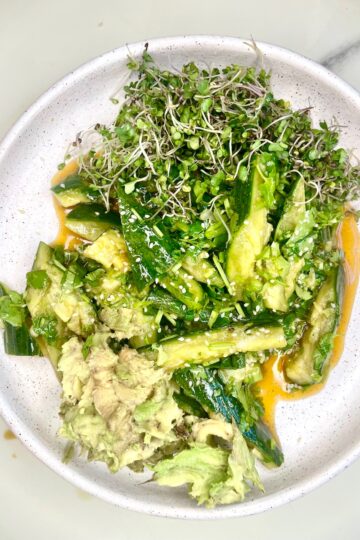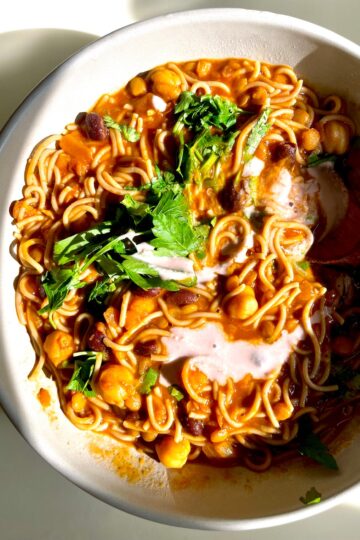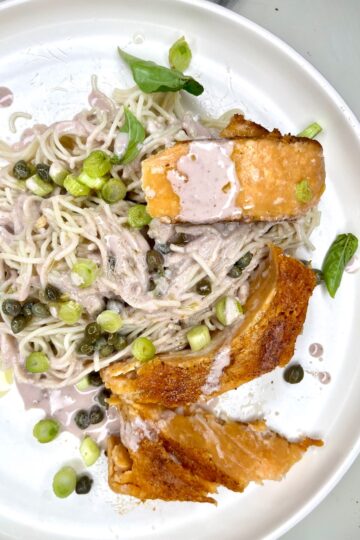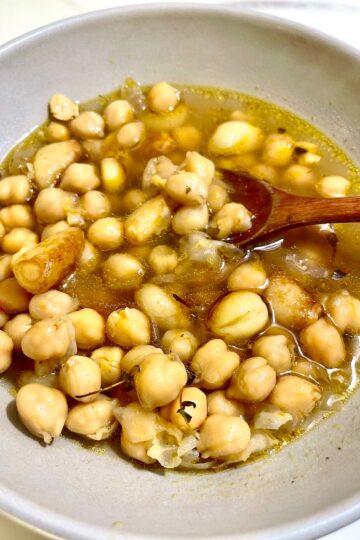What’s better and more comforting than a big dollop of tuna salad, on greens, on a sandwich or just on its own. Good for packed lunch, learn to make this vegan version of your favorite to share with yourself and loved ones. This mock tuna salad is an easy lunch, mixing vegan mayonnaise and mashed chickpeas, seasoned with dijon mustard and nori sheets will make any tuna fan happy. Serve on bed of greens or with crisp celery it is a great alternative to the classic tuna salad.

Why this is the best
There are several reasons why this chickpea tuna recipe is considered the best:
- Health benefits: Chickpeas are a great source of plant-based protein, fiber, and various vitamins and minerals.
- Vegan-friendly: By using chickpeas and vegan mayo instead of animal-based ingredients, this recipe is suitable for those following a vegan or vegetarian diet. It allows individuals to enjoy a tuna-like flavor and texture without the use of any animal products.
- Umami flavor: The addition of roasted nori, which is a type of seaweed, brings a unique umami flavor to the dish.
- Aromatic and refreshing: Sesame oil and cilantro contribute to the overall aroma and taste of the recipe.
- Crunch and texture: Bell pepper and onion add a pleasant crunch to the chickpea tuna.
- Seasoning: The inclusion of Old Bay seasoning adds a delicious blend of spices, including celery salt, paprika, black pepper, and more.
Jump to:
Ingredients

- Can of Chickpeas: Chickpeas, also known as garbanzo beans, are a nutrient-dense legume packed with protein, fiber, and essential vitamins and minerals.
- Vegan Mayo: Vegan mayo is a plant-based alternative to traditional mayonnaise, typically made from ingredients like soy milk, vegetable oil, vinegar, and spices.
- Roasted Nori: Roasted nori is a type of seaweed commonly used in Japanese cuisine, particularly for making sushi rolls.
- Sesame Oil: Sesame oil is a flavorful oil derived from sesame seeds.
- Cilantro: Cilantro, also known as coriander leaves, is a herb commonly used in various cuisines worldwide.
- Bell Pepper: Bell peppers come in various colors, including red, yellow, and green, and are rich in vitamins A and C.
- Onion: Onions are a staple ingredient in many cuisines worldwide.
- Old Bay Seasoning: Old Bay seasoning is a blend of herbs and spices commonly used in seafood dishes.
See recipe card for quantities.
Instructions

Combine all ingredients into a large bowl

Mash with potato masher or wooden spoon.
Make a sandwich with lettuce, tomato & vegan cheese.
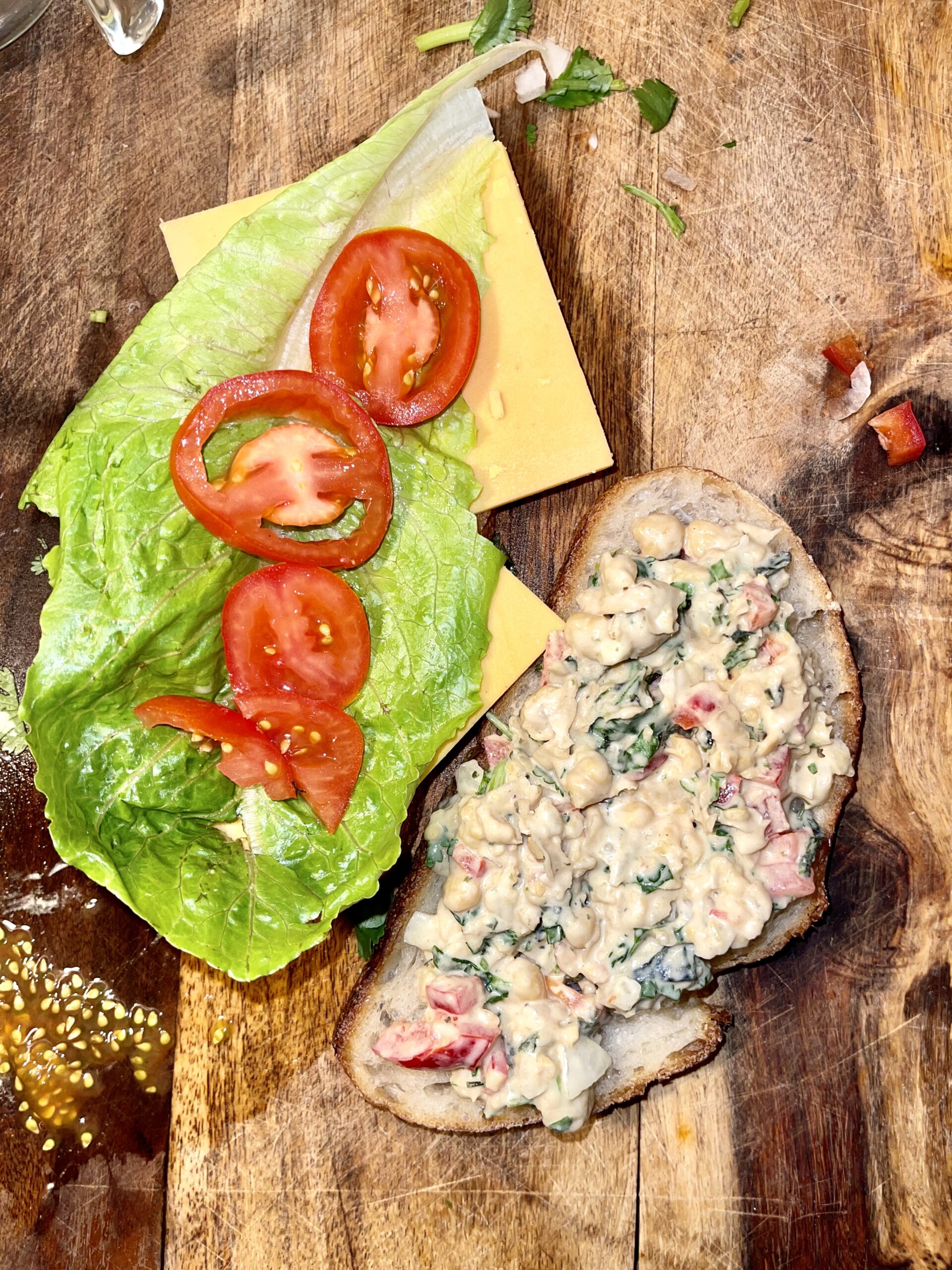

Enjoy ❤️
Hint: One helpful hint for this recipe is to make sure to thoroughly drain and rinse the chickpeas before mashing them. This will help remove any excess liquid and ensure a better texture for the chickpea tuna. Additionally, if you prefer a smoother consistency, you can use a food processor instead of mashing the chickpeas by hand.

Substitutions
- Chickpeas: If you don't have chickpeas on hand, you can substitute them with other types of whole beans like white beans or black beans.
- Vegan Mayo: If you don't have vegan mayo, you can make your own by blending silken tofu, lemon juice, and a touch of mustard until smooth.
- Roasted Nori: If you don't have roasted nori, you can use other types of seaweed like dulse or kombu.
- Sesame Oil: If you don't have sesame oil, you can substitute it with other oils like olive oil or avocado oil.
- Cilantro: If you're not a fan of cilantro, you can substitute it with parsley or basil for a different herbaceous flavor.
- Bell Pepper: If you don't have bell peppers, you can use other crunchy vegetables like cucumber, celery, or grated carrots for added texture and freshness.
- Onion: If you don't have onion, you can use shallots or green onions as a substitute. They will provide a similar flavor profile.
- Old Bay Seasoning: If you don't have Old Bay seasoning, you can create your own blend using a combination of spices like paprika, celery salt, black pepper, cayenne pepper, and garlic powder. Adjust the quantities to your taste preferences.

Variations
- Mediterranean Chickpea Tuna: Add diced cucumber, cherry tomatoes, Kalamata olives, and crumbled feta cheese to the chickpea mixture. Season with lemon juice, dried oregano, and a drizzle of olive oil for a Mediterranean twist.
- Spicy Chickpea Tuna: Add diced jalapenos or a pinch of cayenne pepper to the chickpea mixture for some heat. You can also include diced red onion, chopped cilantro, and lime juice for a zesty kick.
- Curry Chickpea Tuna: Mix in curry powder, turmeric, and a squeeze of lemon juice to the chickpea mixture. Add diced mango, raisins, and chopped cashews for a sweet and savory curry-inspired flavor.
- Avocado Chickpea Tuna: Mash in ripe avocado to the chickpea mixture for a creamy and rich texture. Add diced red bell pepper, chopped red onion, lime juice, and a sprinkle of cumin for a refreshing avocado twist.
- Dill Pickle Chickpea Tuna: Finely chop dill pickles and mix them into the chickpea mixture. Add diced red onion, chopped fresh dill, a squeeze of lemon juice, and a dollop of mustard for a tangy and pickle-infused flavor.
- Smoky Chipotle Chickpea Tuna: Mix in chipotle peppers in adobo sauce, smoked paprika, and a squeeze of lime juice to the chickpea mixture for a smoky and spicy flavor. Add diced red onion, chopped cilantro, and a sprinkle of cumin for extra depth.
- Feel free to get creative and customize the chickpea tuna recipe with your favorite flavors and ingredients. These variations can be enjoyed in sandwiches, wraps, salads, or as a dip with crackers or veggies.
Equipment
The equipment needed for this chickpea tuna recipe is minimal and commonly found in most kitchens. Here's a list of the basic equipment you'll need:
- Mixing Bowl: A medium-sized mixing bowl will be used to combine and mix the ingredients together.
- Fork or Potato Masher: You'll need a fork or a potato masher to mash the chickpeas to the desired texture.
- Cutting Board and Knife: A cutting board and a sharp knife will be needed to chop the bell pepper, onion, cilantro, and any other ingredients you choose to add.
- Measuring Spoons: Measuring spoons will be useful for accurately measuring the sesame oil, Old Bay seasoning, and any other spices or seasonings you decide to include.
- Spoon or Spatula: A spoon or spatula will be used to mix the ingredients together and ensure they are evenly combined.
- Optional: Food Processor or Blender: If you prefer a smoother texture for the chickpea tuna, you can use a food processor or blender instead of mashing the chickpeas by hand.
These are the basic equipment items needed for this recipe. However, feel free to use any additional kitchen tools or gadgets that you find helpful for your cooking process.
Storage
To store the chickpea tuna, follow these guidelines:
- Refrigeration: Transfer any leftover chickpea tuna to an airtight container. It can be stored in the refrigerator for up to 3-4 days. Make sure to keep it chilled at all times to maintain freshness.
- Freezing: If you want to store the chickpea tuna for a longer period, you can freeze it. Place the chickpea tuna in a freezer-safe container or freezer bags, ensuring all the air is squeezed out. It can be stored in the freezer for up to 2-3 months.
- Thawing: When you're ready to use the frozen chickpea tuna, transfer it to the refrigerator and allow it to thaw overnight. Once thawed, give it a good stir to redistribute any moisture that may have separated.
- Note: The texture of the chickpea tuna may change slightly after freezing and thawing, as the ingredients may release some moisture. Adjust the seasoning and add a little extra mayo or other desired ingredients to refresh the flavors, if needed.
Remember to always use proper food safety practices and discard any chickpea tuna that has been left at room temperature for more than 2 hours or shows signs of spoilage.
Top tip
One top tip for this chickpea tuna recipe is to let the flavors meld together by allowing the mixture to sit in the refrigerator for at least 30 minutes before serving. This will give the ingredients time to blend and enhance the overall taste. The flavors will become more pronounced and the texture will also improve as the ingredients marinate. So, if possible, plan ahead and prepare the chickpea tuna in advance to allow for this resting time.
FAQ
A: Yes, you can use dried chickpeas instead of canned chickpeas. Soak the dried chickpeas overnight, then cook them until tender before mashing them for the recipe.
A: Yes, if you prefer a non-vegan version, you can substitute canned tuna for the chickpeas. Simply drain the tuna and flake it with a fork before mixing it with the other ingredients.
A: Yes, this recipe can easily be made gluten-free. Just ensure that the ingredients you use, such as the vegan mayo and Old Bay seasoning, are gluten-free or substitute them with gluten-free alternatives.
A: Absolutely! The seasonings in this recipe can be adjusted to suit your preferences. Feel free to add more or less of any ingredient, such as the Old Bay seasoning, sesame oil, or fresh herbs, to achieve the desired flavor profile.
A: Yes, you can make the chickpea tuna ahead of time. It can be stored in the refrigerator for a few days, allowing the flavors to develop even more. Just keep it in an airtight container and give it a good stir before serving.
A: Definitely! The chickpea tuna can be served in various ways. It can be enjoyed as a sandwich filling, wrapped in a tortilla or lettuce leaves, or even served on top of a salad. Get creative and use it in any way you like!
A: Absolutely! This recipe is versatile, and you can add other ingredients to customize it to your liking. Consider adding diced vegetables, herbs, spices, or even a squeeze of lemon juice to enhance the flavors and make it your own.
A: Yes, you can easily double or triple the recipe to make a larger batch for a crowd. Just adjust the ingredient quantities accordingly and ensure you have a larger mixing bowl to accommodate the increased volume.
Related
Looking for other recipes like this? Try these:
Pairing
These are my favorite dishes to serve with [this recipe]:

Vegan Chickpea Tuna Salad
Ingredients
- - 2 cans 15 ounces each of chickpeas, drained and rinsed
- - ¼ cup vegan mayo
- - 1 tablespoon lemon juice
- - 1 teaspoon dijon mustard
- - ¼ cup finely chopped red bell pepper
- - ¼ cup finely chopped red onion
- - 2 tablespoons chopped fresh cilantro
- - 1 sheet of roasted nori finely chopped
- - 1 tablespoon sesame oil
- - 1 teaspoon Old Bay seasoning adjust to taste
- - Salt and pepper to taste
- These measurements are a guideline and you can adjust them according to your taste preferences. Feel free to add or reduce any ingredient to suit your liking. Enjoy your chickpea tuna salad!
Instructions
- Drain and rinse a can of chickpeas. Place them in a mixing bowl.
- Mash the chickpeas using a fork or potato masher until they reach a flaky texture, resembling the consistency of tuna.
- Add vegan mayo to the mashed chickpeas. Start with a few tablespoons and adjust according to your desired creaminess. Mix well to combine.
- Finely chop roasted nori sheets and add them to the chickpea mixture. The nori will provide a subtle seafood-like flavor. Mix well.
- Drizzle sesame oil over the mixture, starting with a teaspoon and adjusting to taste. Sesame oil adds a nutty flavor, so be careful not to overpower the other ingredients. Mix well.
- Chop fresh cilantro, bell pepper, and onion into small pieces. Add them to the chickpea mixture for added crunch and flavor. Mix well to distribute the ingredients evenly.
- Sprinkle Old Bay seasoning over the mixture, starting with a teaspoon and adjusting to taste. Old Bay seasoning adds a savory and slightly spicy flavor. Mix well to incorporate the seasoning.
- Taste the chickpea tuna mixture and adjust the seasoning or other ingredients according to your preference.
- Serve the chickpea tuna on bread, in a wrap, or on top of a salad. It can be enjoyed immediately or refrigerated for a few hours to allow the flavors to meld together.
- Enjoy your delicious and vegan-friendly chickpea tuna!
- Note: Feel free to customize the recipe by adding other ingredients like lemon juice, mustard, or pickles for additional flavor variations.


